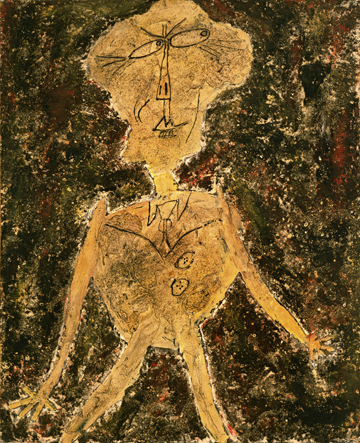Art Review: Monsieur Plume: An Existential Anti-Hero
By Ina Cole
ART TIMES May 2016 online
In 1946-47 Jean Dubuffet created a series of six portraits depicting the misfortunes of an enigmatic figure known as Monsieur Plume. But who was Monsieur Plume? He repeatedly appears in paintings and texts of the time, in the guise of a shadowy chameleon-like voyager. The mysterious Plume was, in fact, an absurd manifestation of the artist and writer Henri Michaux, who had created this fictional character as a doppelganger, placing him within irrational situations that unravel through a series of narratives. The portraits of Plume, as created by Dubuffet, belong to a larger group of works the artist had made at the request of the American millionairess, Florence Gould, which depicted the writers, artists and intellectuals that regularly frequented her salon in the city of Paris.
Plume echoes Michaux’s view of life and becomes a witness to the existential crisis of post-war Paris. At the time Europe was restoring itself after the Second World War, prompting an analysis of the human condition in light of the carnage that had been wrought. Belief systems were shook to the core and Dubuffet and his circle played a key role in leading national consciousness to new levels of understanding. In particular, it was thought that the disintegration of the body in art could heighten the expressive presence of human form, as captured in painting and sculpture. Dubuffet spoke of paintings that “aim to show the immaterial world which dwells in the mind of man: disorder of images, of beginnings of images, of fading images, where they cross and mingle, in a turmoil, tatters borrowed from memories of the outside world, and facts purely cerebral and internal”.
The disintegration Dubuffet describes is fully explored in his portraits of Plume. Two of the most well-known are Monsieur Plume Botanical Specimen and Monsieur Plume with Creases in his Trousers, both of which simultaneously function as portraits of Michaux. In Monsieur Plume Botanical Specimen Plume’s head looms large and his face wears a quizzical frown, whilst his eyes swivel to one side emphasizing a somewhat furtive appearance. Plume’s fingers are nervously splayed, and his spindly legs strangely devoid of feet. Dubuffet favored intractable materials and the mixed media technique he used suggests that the character has emerged from a murky but geologically rich environment, rendering him a fossilized specimen rather than a fully integrated member of the human race. This hybrid creature, nonetheless, strives for communication in the way he pushes against the painting’s borders to face the viewer, and it is precisely this gesture that endows the painting such poignancy.
Similarly Monsieur Plume with Creases in his Trousers uses oil paint and grit on canvas, yet in this version the figure seems to have become a negative, losing the solidity present in his depiction as botanical specimen. Plume’s outline is notably pale and sparse, roughly scored into thick paint, and his face is as pitted and creased as his shambolic attire. He is essentially passive yet, in Michaux’s stories, carries out the most atrocious acts of violence due to circumstances beyond his control. Plume is distinctly tragicomic, and has been compared to Camus’s Meursault, Sartre’s Roquentin, even Charlie Chaplin. This absurdist territory has been fully explored in the writings of Kafka and Beckett. It is an enduring subject; that of the powerless individual consumed by incomprehensible inner forces and farcical bureaucratic structures. The creation of the ever-fallible Plume, therefore, can be seen to be as relevant now as during the post-war era of his creation.
All the portraits created at Florence Gould’s request have a strong element of the grotesque and caricature, and when first exhibited horrified audiences in their crude representation of humanity and dense composite medium utilized in their rendering. Dubuffet quickly became the bête noire of the Paris avant-garde and his reputation soared. He had successfully subverted the laws of painting and his experiments and theories bore a strong influence on European and American art in the 1950s and 1960s. Furthermore, his influence on later artists, such as Jean-Michel Basquiat and Keith Haring, remains clearly apparent. It is perhaps not surprising that Dubuffet and his contemporaries gravitated towards creating harrowing work, where figures appear to be fused from mismatched body parts and unanimously exude an unforgiving sense of displacement. Many post-war artists had been forced into an isolated existence during the war years, their artistic output clandestine. All they witnessed, therefore, remained ingrained in the psyche, long after the war had ceased.
Monsieur Plume Botanical Specimen is in the collection of Albright-Knox Art Gallery, Buffalo, New York and can be seen at the Beyler Foundation, Switzerland to 8 May as part of an exhibition of over 100 works by Dubuffet. Monsieur Plume with Creases in his Trousers is in the collection of Tate Modern, London. The first museum exhibition of Dubuffet’s drawings is on view at the Morgan Library & Museum, New York from 30 September to 2 January 2017.

